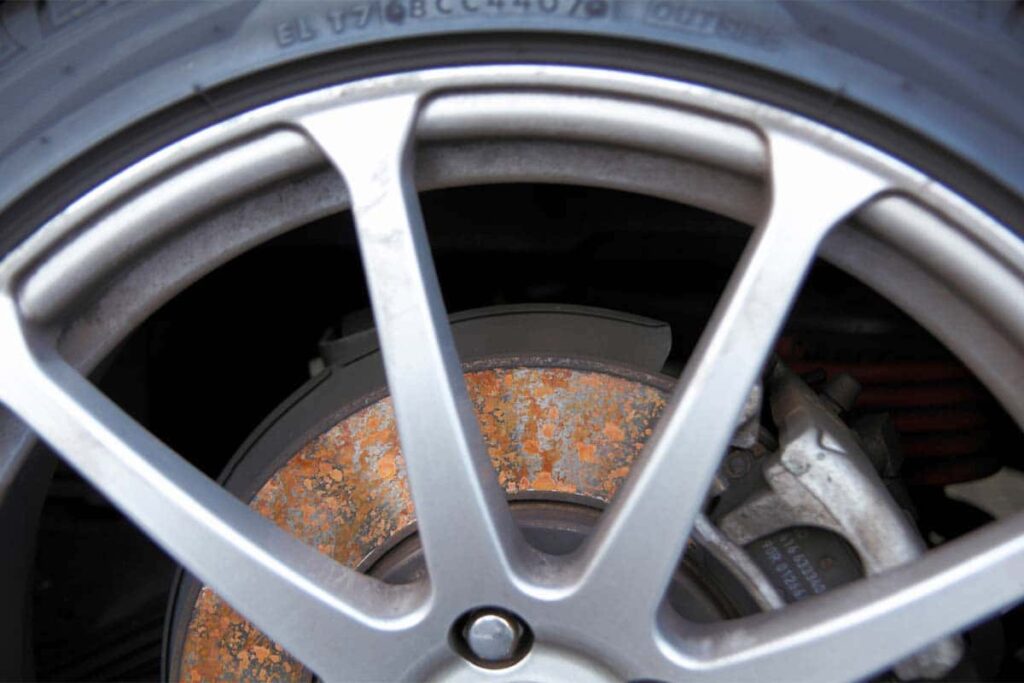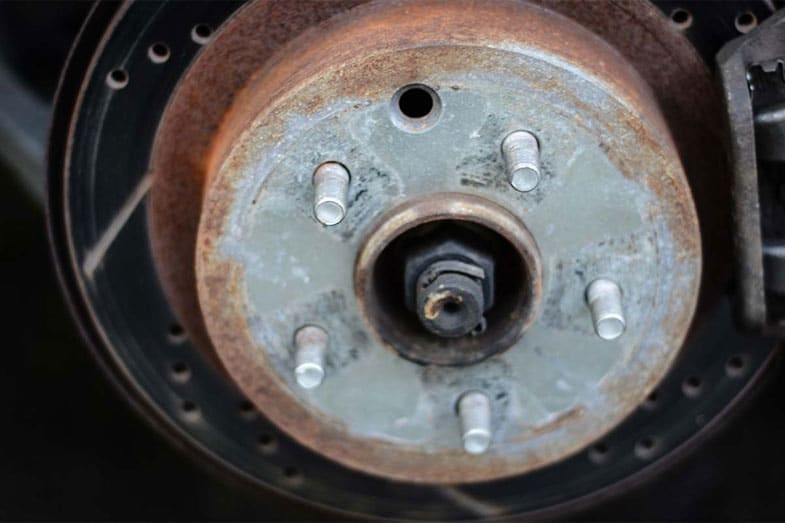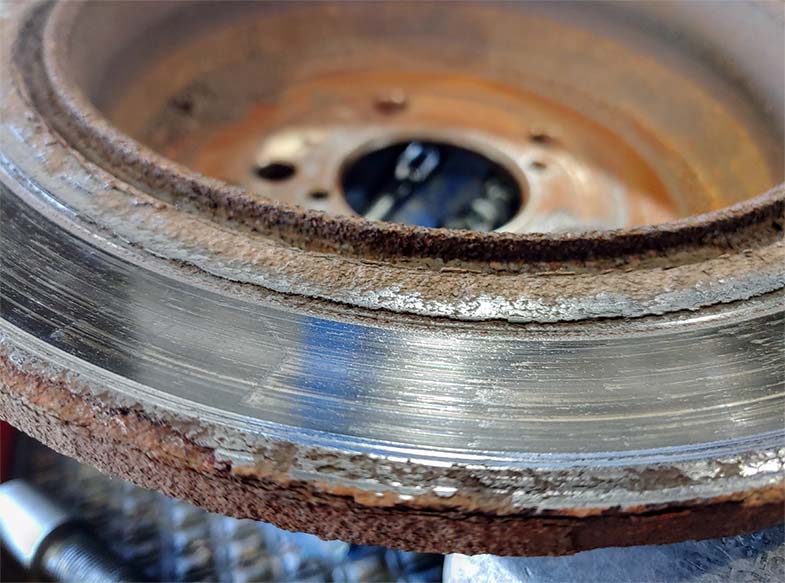How Do You Know When Front Rotors Are Bad
A warped brake rotor is one of those wear-and-tear car problems that would be folly to ignore. Non only does fixing it become pricier the more it gets delayed, but it is as well one of the worst issues to take, given the level of risk it puts a driver in when on the road. Some of its symptoms commencement rather quietly and may non be noticeable to the untrained eye – which is why learning how to tell if a brake rotor is bad is extremely important.
There are several ways to spot bad rotor symptoms. By feel, sound, or visual inspection, you should be able to define if indicators such equally pulsation/vibration, wobbling, grooves/scoring, blue marks, and screeching or grinding noises signal to defective rotors or some other brake component.
Hither are 15 common signs of a bad rotor you should exist aware of:
- Vibration in the steering wheel
- Pulsating brake pedal
- Intermittent brake noises
- Grinding when hitting brakes
- Screeching afterwards brake pad installation
- Out-of-round rotors
- Deep grooves or score marks
- Cracked rotors
- Blue discoloration
- Corrosion
- Stiff chemical fumes
- Wobbling or rotor runout
- Lopsided, inconsistent braking
- Oversensitive/insensitive brakes
- Longer stopping distances
Determining what causes rotors to become bad apace is not exactly a piece of cake, fifty-fifty for long-time vehicle owners. But with more than repair feel and a little help from this guide, you will be well on your manner.

Signs of a Bad Rotor
1. Vibration in the Steering Wheel
When hitting the brakes, your brake pads press confronting the smooth, flat surface of the rotors to halt or slow down your vehicle. This friction causes the brake rotors to become extremely hot (not to mention receive pregnant amounts of pressure), resulting in the rotors becoming bent, uneven, or warped over time.
Structurally, rotors and calipers are attached to the same spindle where the wheels are connected. So, if the rotors lose their smoothness, the feeling of unevenness or vibration transmits through the spindle and eventually reaches the steering wheel. Consequently, steering volition non feel equally smooth equally it used to exist with rotors and brake pads in expert condition.
two. Pulsating Brake Pedal
The cause of this symptom is similar to the first item in this list – warped, bent, or uneven brake rotors. Only instead of the steering cycle, the pulsation is generally felt in the restriction pedal. This feeling may be completely isolated in that expanse or peradventure detected in other parts of the vehicle. Another reason for the pulsation is that your rotors may exist nearing runout.
Ane way to help prevent premature warping of your restriction rotors is to ensure your restriction components are capable of proper heat dissipation. Since the restriction arrangement creates friction-based estrus to put your vehicle to a halt, brake parts mustn't overheat more they should. Otherwise, the excessive heat tin can cause the restriction rotors to buckle, plus other components to be prone to failure or damage.
Skimping on rotor replacement is also not advisable. Cheaper, lightweight brake components do non contain sufficient material to dissipate heat and may but be added salt to injury. Ceramic, stainless-steel, or cantankerous-drilled slotted brake rotors are e'er the all-time replacements due to their college tolerance for oestrus and effectiveness for heat dissipation.
3. Intermittent Brake Noises
Persistent brake noises are often interpreted every bit a guaranteed bad rotor sound. Nonetheless, this may not ever be the case. It takes keen listening skills to tell the departure betwixt racket coming from a warped rotor and the odd sound from a vehicle left overnight in the open up accumulating wet. This latter type of sound is actually normal and goes away after driving for a while. Information technology is besides piece of cake to prevent by keeping your car indoors when the conditions is snowy, rainy, or humid.
What you should await out for is squealing, which indicates brake article of clothing or severely worn-out restriction pads. Subsequently all, squealing or squeaking occurs when the brake pad wear indicator hits the brake rotor. This noise could also be from a very dirty vehicle or a buildup of restriction dust.
Service your brakes and immediately change the restriction pads when this happens, equally continuing to employ worn pads poses a huge condom chance while on the route. Non to mention that information technology can overheat other brake components and crusade excessive brake material buildup on the rotors. Scraping is another affair to be wary of, equally it is a sure sign of worn rotors and pads. In almost cases, scraping noises lead to rotors that have already developed deep grooves or edges.
four. Grinding When Hitting Brakes
Grinding noises emitted from your vehicle during braking is another ways of how to tell if a brake rotor is bad. This noise comes from brake pads that take already worn down to the brake system'due south metallic backing plate. In this scenario, the latter grinds into the restriction rotor's surface, thus creating the sound. Either that or you lot have a pebble or another type of droppings stuck inside your brakes.
Whether the grinding noise is debris-related or not, it is an indication that your brake rotors are already beyond repair and would accept to be immediately replaced with new ones. Seek a professional's evaluation if you suspect strange material inside your brakes is causing the grinding sound. As well, information technology is best to change your brake pads while y'all are at information technology to ensure the contact expanse between the rotors and brake pads is even on all fours of your vehicle.
5. Screeching After Brake Pad Installation
Although new brake pads take some time to settle in after installation, loud screeching sounds should not be regarded as normal. This high-pitched noise indicates that your rotors are glazed or the edges are burnt due to excessive rut. Upon inspection, you may also run across a dark ring or blue marks (discussed further in a later part of this guide) on the rotor surface. If you have not had your new brake pads for long yet, taking it easy on the brakes when at high speeds may eradicate or reduce the occurrence of screeching. Otherwise, it may exist time to replace those rotors.
6. Out-Of-Round Rotors
Apart from unusual vehicular sounds, visually inspecting brake components is some other effective style to identify bad rotor symptoms. Past performing regular inspections, drivers can tell a adept rotor vs bad rotor. Usually, they observe a lip effectually the edge of the brake rotor or thinning of the rotor surface, especially in older vehicles with severely used brake systems. Nevertheless, if y'all want to determine whether your rotors are out-of-rounds or require resurfacing, yous will need proper measurement devices to measure the roundness and thickness of each rotor face. Or you tin take it done in an auto shop.
seven. Deep Grooves or Score Marks
This is, perhaps, the near obvious reply to the question,"What does a bad rotor look like?" A healthy restriction rotor typically has a apartment surface that is smooth both to the eyes and touch. The smoothness of the rotor face helps ensure its good contact with the brake pads, preventing the latter from wearing also deep into the rotor.
A restriction rotor that looks like the opposite of this description is guaranteed to have bad contact with the restriction pads — hence, damaged brake rotors atomic number 82 to impaired brake functioning. Although these surface imperfections accumulate over time, they sometimes manifest due to driving habits or braking arrangement abuse. Grooves/scoring on the rotor face is always a sign for immediate brake rotor/pad replacement and must never be delayed or overlooked.
8. Cracked Rotors
Cracks or gouges can develop in brake rotors later being subject field to extremely high temperatures. The excessive estrus and so causes the restriction rotor to form dents on its surface. These cracks do not impede the part of the brake rotors, provided they are only on the surface level. Withal, deeper cracks pose greater risks and may even be early on signs of a brake rotor snapping in half.
Different with tires (where you would just need replacement once you have reached the tire tread limit), it is unwise to maximize the use of a brake rotor to the betoken of runout. Even earlier y'all accomplish that stage, you lot have near likely already experienced major inconveniences in halting your vehicle. To go on driving your car with a broken rotor would be nonsensical, not to mention dangerous.
9. Blue Discoloration
Blue marks on the surface of your brake rotors usually precede worse office issues such equally rotor cracks, faulty calipers and brake shoes, and uneven wear on the brake pads. The discoloration is from excessive estrus attributed to riding the brakes, incorrectly aligned brake calipers, or insufficient heat dissipation by stock brake components. In some cases, it is due to unexplained force per unit area being applied to the restriction pads even if the brake system is not engaged.
Seeing blue rotors should prompt you to perform a brake inspection on your motorcar. It will exist in your best interests to observe out correct abroad which of the components mentioned above are lacking or in demand of replacement — and so that y'all do not run the adventure of getting into more than serious braking system issues. Veterans recommend replacing discolored rotors with cross-drilled slotted rotors and the restriction pads with ceramic ones to improve oestrus dissipation.
x. Corrosion
Momentary rust germination is expected during winter or the rainy season due to wet buildup in the vehicle (and in its brake organization components), especially when left outdoors. Merely it is a unlike story for a machine that is well-maintained and stored inside the garage. Should you notice rust forming around the outer edge of your brake rotors, and so make sure to replace them sooner than after.
When not attended to, slight corrosion on the rotor surface can atomic number 82 to grinding noises and rough braking. There would also be rust pitting in the brake pads, contact area, or vanes. Worst-case scenario, the brake rotors can go stuck due to excessive rust brought about past oxidation, making it extremely difficult for either the vehicle owner or a professional mechanic to remove and replace.

11. Strong Chemic Fumes
Chemic odors coming from your vehicle can signify overheated brakes or malfunctioning calipers (one that is locked in identify), potentially leading to brake failure. Faulty restriction calipers, in item, tin put too much stress on a brake rotor, causing it to exist warped or get off-balanced. Sometimes, smoke comes from the afflicted wheel. Meanwhile, brake rotors give off the sharp, unpleasant smell due to existence overheated simply have no smoke accompaniment.
Should you feel either one of these scenarios, make sure to pull over a roadside and let your brakes cool downwards starting time. After a catamenia of rest, go along with driving but use your braking system in moderation. Once you are in a safe location, attend to firsthand repairs (or replacement) of your calipers, brake pads, and rotors.
12. Wobbling or Rotor Runout
Contrary to popular belief, wobbling is not only an early sign of wheel runout only also of damaged wheel bearings (or bearings with excessive play). The latter does not merely occur when driving over 70 mph, leading to warped rotors and uneven brake pad wear. Cycle runout nonetheless needs to be examined since it negatively impacts how a restriction rotor functions. Yet, ensuring wheel bearings are torqued to spec and in proficient status is crucial, besides.
13. Lopsided, Inconsistent Braking
Incidents of vehicles pulling only to ane side when engaging the brakes accept a variety of probable causes – among them a bad brake hose or a caliper issue. Information technology may exist hard to pinpoint this problem at starting time. But once you lot do, determining whether the front or rear brakes are defective becomes easier.
If ane brake is noticeably working harder than the other (resulting in the machine pulling only to one management when halting), chances are your front brakes are at fault. Plus, the side the vehicle pulls toward is where the working brake is. But if the lopsidedness of the brakes is close to negligible, it is probably the rear brakes needing inspection and rear calipers that are not performance properly.
14. Oversensitive/Insensitive Brakes
For vehicles with hydraulically-operated brake discs, communicable this braking system behavior early makes a world of difference in how much an owner will end up spending for repairs and replacement parts. There are ii sides to this issue — one is you barely bear on the brake pedal, but braking still engages. The other is having to depress the pedal nearly the indicate of being snapped off the bushing merely to go it to piece of work.
If you discover yourself in either state of affairs when pressing the brakes, information technology could mean depression brake fluid, air in the brake lines, overly sparse restriction pads, or a bigger problem involving your vehicle'due south hydraulic arrangement. While these practice not directly impact your brake rotors, they would somewhen — if not properly diagnosed and resolved.
15. Longer Stopping Distances
In the absence of telltale signs involving one's sense of aroma or touch, this is probably the most obvious sign to tell if a brake rotor is bad. Experienced drivers can easily recognize something has gone awry with the braking system through its functioning. For case, warped/damaged brake rotors would naturally compromise a vehicle'southward overall braking system functionality. This may manifest in that car'southward inability to stop at an acceptable altitude — a.yard.a. braking system fade orbrake fade.
Brake fade commonly happens during loftier-performance driving or going downwardly steep descents. It is likewise a upshot of contaminants on the brake rotors, causing the restriction pads to lose grip and slide over the rotor surface. Withal, it can also be a gradual outcome of repeated/sustained brake use, peculiarly when driving a vehicle nether heavy load or in high-speed situations. Decrepit rotors somewhen incur chips and uneven surfaces — imperfections that reduce restriction efficiency since the pads get less braking surface on the rotors.
How Long Do Restriction Rotors Final?
On average, one restriction rotor will terminal 2-3 sets of restriction pads before nearing its runout. But if you need a guide, brake rotors are stamped with a minimum thickness specification. Vehicles used for high-speed racing or hauling will surely have rotors with less-than-average life cycles. It does matter whether a restriction rotor is old, brand-new, or resurfaced. Its brand and fabric should also be considered.
In mileage, rotors given proper brake inspections, timely brake pad changes, and even vesture can last from 15,000 to 100,000 miles before warranting replacement. Still, these figures can change depending on driving habits, riding weather, and frequency of budget or servicing. The health of other brake system components also largely affects the longevity of your rotor. Hence, it is best to account for these factors before pushing the limits of your braking system.
When Should I Become Them Replaced?
Ultimately, the response to this question depends on the severity of damage your brake rotor has sustained. Pocket-sized scratches on the rotor surface tin can all the same be remedied past machining the discs. Only if the rotor is too warped or damaged, then a replacement would exist more than suitable. Better side with caution and replace the rotors before they are completely worn out, instead of risking meeting a catastrophe on the road.
In some instances, a different brake component may need a replacement to prevent (further) damage to your brake rotors. While in others, y'all volition have to automatically become new restriction pads with them. You lot should be able to decide whether to tarry or immediately proceed with replacement later on following these simple steps:
How Do I Check My Rotors?
- Lift your car off the footing with a jack stand up and remove the lug nuts from the wheels.
- Have off the tires and wheels to expose the restriction rotors.
- Loosen the bolts on your restriction calipers to remove them.
- Remove the brake pads and rotors from your vehicle for inspection.
- Thoroughly examine the rotor faces and outer/inner edges for any grooves, scoring, or unevenness.
- Practise the same for the restriction pads and ensure they have not still reached their minimum thickness requirement.
- Clean all brake components, including the mounting surface for your brake rotor.
At this stage, you should see whatsoever deformities to the brake rotor or damage to individual brake organization components. Your findings should bespeak you toward your side by side course of action.
Decision – How to Tell if Rotor Is Bad

To review, here are fifteen common signs of a bad rotor:
- Vibration in the steering cycle
- Pulsating brake pedal
- Intermittent restriction noises
- Grinding when striking brakes
- Screeching after brake pad installation
- Out-of-round rotors
- Deep grooves or score marks
- Cracked rotors
- Blue discoloration
- Corrosion
- Strong chemical fumes
- Wobbling or rotor runout
- Lopsided, inconsistent braking
- Oversensitive/insensitive brakes
- Longer stopping distances
Remember, driving around with a bad rotor or repeated occurrences of whatsoever of these symptoms is a definite no-no. For this reason, you should opt to immediately replace warped rotors or have a professional mechanic deal with the issue if it becomes too complicated. Inevitably, even the best-quality restriction rotors are bound to reject. Just with expert driving habits, regular vehicle inspection, and strict adherence to scheduled maintenance, you should be able to prevent pricey repairs and further brake system damage.
Source: https://offroadingpro.com/how-to-tell-if-rotor-is-bad/
0 Response to "How Do You Know When Front Rotors Are Bad"
Post a Comment